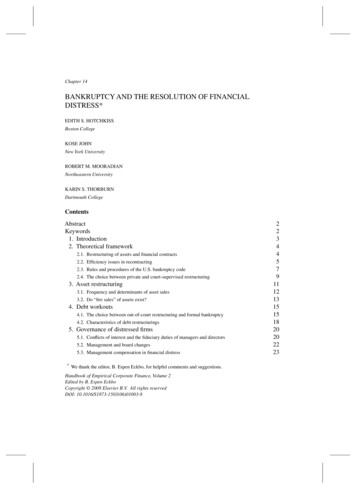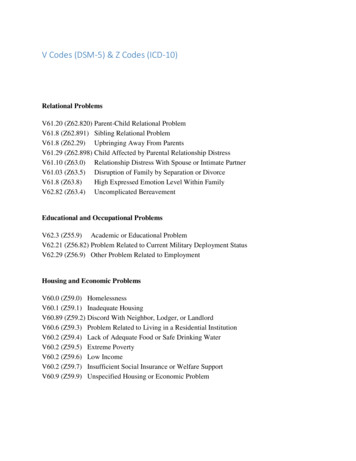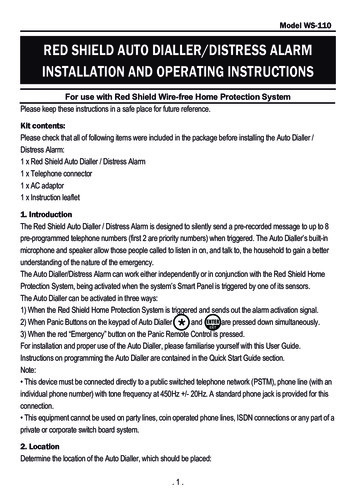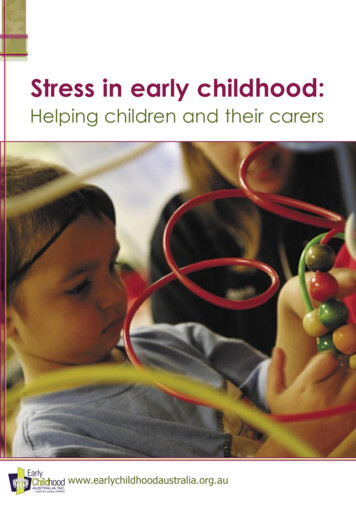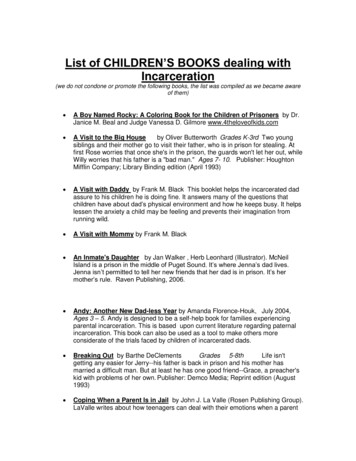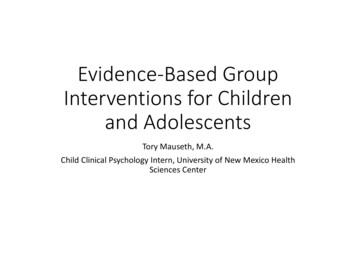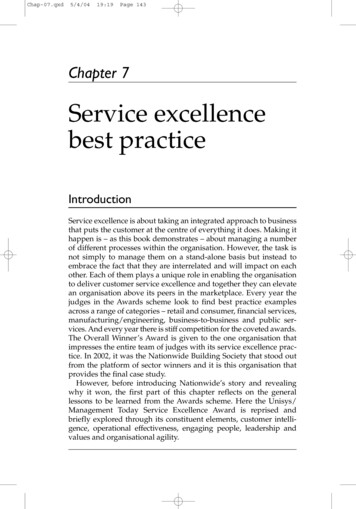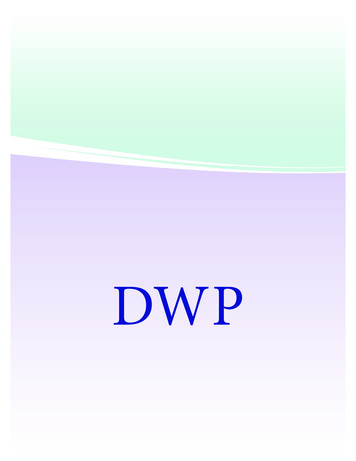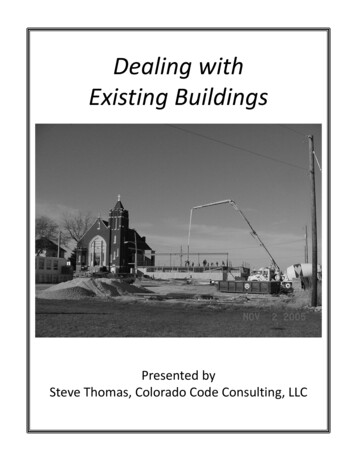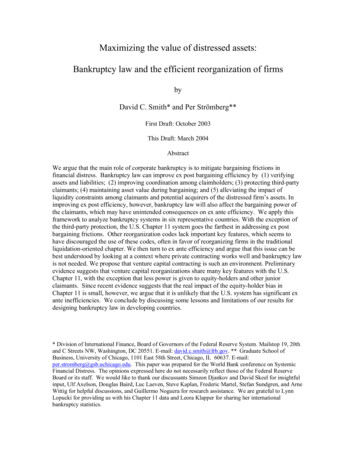
Transcription
Dealing with DistressAn introduction to healthy coping strategiesCarol Vivyan2009www.get.ggwww.getselfhelp.co.uk
1ContentsPage2IntroductionDistress Tolerance3IMPROVE & ACCEPT (acronyms in italics)4Distraction & Pleasurable Activities4-7Relaxation8Safe Place Visualisation11Positive Affirmations12Mindfulness11Wise Mind17Wise Inner Advisor Visualisation19Colour Breathing20Emotion Regulation21Opposite Action, Opposite Emotion, PLEASE Master22Emotions and their associated thoughts and reactions24Dealing with Negative Emotions – quick reference25Dealing with Distress Worksheets26Questions to ask when you‟re distressed28Fact or Opinion?29Interpersonal Effectiveness30DEAR MAN & GIVE30FAST31Assertiveness32Communication Styles – Passive, Assertive, Aggressive33Handling Criticism34Saying No36Telling others what we want37STOPP – 5 steps to deal with distressing situations38The Helicopter View39Positive Steps to Wellbeing40Further copies are available to freely download from ww.getselfhelp.co.uk Carol Vivyan 2009, permission to use for therapy purposeswww.get.gg
2IntroductionThis booklet is only intended as an introduction to (or reminder of) healthy coping strategies usedto help us deal with distress, using the headings from the core skills used in DBT (DialecticalBehaviour Therapy):When we feel upset or distressed, we normally react automatically, without thinking about theconsequences. And we can often get into the habit of using unhelpful and often self-destructivebehaviours to help us cope. These may include: Self-harm including cutting or taking „overdoses‟Under or over-eatingUsing or relying on drugs and alcoholDepending on physical exerciseWhen we use these self-destructive coping behaviours, we often then get caught up in thinkingwe‟re bad for doing them, which makes us feel even worse, and may make us more likely to keepon doing them. A vicious cycle.In order to break that cycle, we can learn to do doings differently, including learning new healthycoping skills which will help us feel better about ourselves and others, and learning to understandand see our thoughts differently.This leaflet aims to suggest introductions to alternative, healthier ways ofcoping, but like with anything else in real life, it‟s not easy or a quick fix –it has to be worked consistently hard at, and the only certainty is that ittakes a lot of practice, practice, practice!www.getselfhelp.co.uk Carol Vivyan 2009, permission to use for therapy purposeswww.get.gg
3Distress ToleranceDistress Tolerance skills are used when we are unable, unwilling, or it would beinappropriate to change a situation. It's important to use the right skills at the righttime. In order to change a situation or emotion, we would use Emotion Regulationskills (page 21).Distress Tolerance skills are used to help us cope and survive during a crisis, andhelps us tolerate short term or long term pain (physical or emotional pain).Tolerating distress includes a mindfulness of breath and mindful awareness of situations andourselves (page 13).Radical AcceptanceAcceptance means being willing to experience a situation as it is, rather than how we want it tobe. Not to be willing (wilfulness) means trying to impose our will on a situation. A willingness toaccept things as they are, not as we think they should be.Repeatedly 'turning the mind'. To be in the actual situation you are in, rather than the situation youthink you're in, or think you should be in. Your mind is always going to give you other ideas,interpretations, reminding you of old strategies. Each time your mind wanders and you noticethese other thoughts and images, simply bring your attention back to this moment. Not judging thesituation to be good, or bad, or in any way. Simply bringing your attention back to this moment,this situation, and being effective in this situation.You may need to 'turn your mind' many many times in a short space of time.What Radical Acceptance is NOT: Not judging the situation to be goodNot giving permission for the situation to go on foreverNot giving up your optionswww.getselfhelp.co.uk Carol Vivyan 2009, permission to use for therapy purposeswww.get.gg
4It can help to use memory aids such as acronyms to remind us of how we can helpourselves during distressing times:IMPROVE the momentIImagery – e.g. safe place visualisation (page 11)Mfind Meaning in the situationPPrayer – meditation, spirituality, affirmations (page 12)RRelaxation (page 8)OOne thing at a timeVVacation – take some time out of the situation, 'me' time, or imaginingyourself on an idyllic beautiful holidayEEncouragement – positive and calming self talkWise Mind ACCEPTSAActivities (see distraction ideas below)CContributing – helping othersCComparisons – comparing self with (better) selfEEmotions – generate different emotions by watchingmovie/TV, listening to music etcPPushing away – thinking about or putting our attention ontosomething elseTThoughts - new thoughts. E.g. counting, playing 10 (10 colours in room,10 musical instruments, 10 fruits, 10 Bond films etc)SSensations – use seeing, hearing, smelling, tasting and touching sensesDistraction IdeasDistraction helps us feel better by diverting our attention away from the distressing thoughts. Itworks even better if you choose something that will really grab your attention and keep youabsorbed in that activity. Different things work for different people. It‟s worth trying and practisingmany of those listed, and more that you think of yourself, a few times each before giving up on it.www.getselfhelp.co.uk Carol Vivyan 2009, permission to use for therapy purposeswww.get.gg
5Home and garden Mow the lawn Clean the car Do some gardening De-clutter a room or part of a room Purge your wardrobe (give to charity) Clear out the spare room (give to charity) Sweep the path Cooking or baking something pleasurable DIY Bath the dog Brush the cat Clean the hutch/cage Re-arrange the furniture in one roomLeisure Do a crossword or sudoku Try out aromatherapy or reflexology Visit the hairdresser – try a new style or colour Watch television or a DVD Play on the computer Surf the internet Watch the clouds whilst lying outside Read a novel or new newspaper or magazine Walk or sit on the beach or parkGetting out Join a leisure centre or health suite Go for a walk or jog Get the old cycle out! Visit a new church Go to the library Visit a museum Check out what movies are on Go to a concert Browse an antiques or charity shop Find out what free classes are on offer Potter around window shopping Go out for lunch Go to the beach – whatever the weather! Learn to drive, or take a trial lesson Visit a nursery, garden centre or park Visit a tourist attraction Walk alongside the sea, river, reservoir or lake Take a bus ride somewhere new Visit an aquarium or zoo Visit a car boot sale Visit a nature reserve Visit a historical or natural site Visit an art exhibition Go for a drive www.getselfhelp.co.uk Carol Vivyan 2009, permission to use for therapy purposeswww.get.gg
6Being creative Take up a new hobby Learn another language Start an evening class Write a letter or article for a magazine Learn to meditate, do yoga or tai chi Start a diary or journal Write a short story or poem Take up a musical instrument Decorate a room, or a piece of furniture Paint, draw, sculpt Join a dance class Surf the internet Create a weblog or site Sew or knit Bake Make an „emergency‟ box for distressing times – put in anysmall reminder of what helps Take photographs Make a scrapbook Sort out your photosSelf Soothing Have an early night Eat something you haven‟t tried before Listen to some favourite (calming or uplifting) music Try a new newspaper or magazine Have a bath or shower Use aromatherapy oils Massage your hands or feet Write a list of things you have achieved, great and small Soak your feet Make a list of things that you can be thankful for Paint your nails Meditate, relax, yoga, tai chi, reiki Cuddle a soft toy Write a letter to yourself Read a letter you‟ve written to yourself to read at thesetimesMaking contact with others Telephone someone you haven't spoken to for a while Join a self-help group Join a civil rights group Do some voluntary work Write a letter to someone you haven‟t written to for a while Talk to a friend or family member Phone the Samaritans or another helpline Join an online support group or discussion forum Email a friendwww.getselfhelp.co.uk Carol Vivyan 2009, permission to use for therapy purposeswww.get.gg
7Express yourself physically Bang a drum! Scream, shout or sing loudly! Rip up a phone book or newspaper Dance energetically to loud music Write – prose, poem, story, music, journal, diary, weblog, whatevercomes into your head Write a letter to someone, but don‟t send it – shred or burn it outside Run, walk, cycle, swim, go to the gym Paint Vacuum enthusiastically Kick a ball against a wall Punch or kick a cushion or pillow CryPositive Self-Talk I can get through this, I‟ve managed before and I can now I don‟t need to do this, it‟ll only make it worse afterwards I‟ll regret it and feel awful later It helps for a few minutes, but then it just makes it worse in the longrun I don‟t want to end up at the hospital again I can cope for another hour – I can take one hour at a time Positive Affirmations (see page 12)www.getselfhelp.co.uk Carol Vivyan 2009, permission to use for therapy purposeswww.get.gg
8RelaxationRelaxation is allowing physical and/or mental tension to be released.Healthy living is a matter of balance. Relaxation is part of the balancingprocess alongside other aspects of your lifestyle such as what you eat, yourphysical activity and how you handle stress. Learning to relax involves a littletime and concentration but these are the only costs involved.It‟s a great help to learn a relaxation technique, to help us unwind and bring our tensions andanxiety under control. There are several books, leaflets or audio tapes which we can useourselves. It‟s a good idea to practise regularly so we can be more prepared for the morestressful times.How Relaxation helps Reduces tiredness – if you can manage everyday life without excessive tensionImproves performance – your performance in work, sport or music can be raised throughself awareness and control of tensionReduces pain – pain occurs as a result of tension e.g. headaches and backache.Relaxation can help you to cope by raising your pain threshold and reducing the amount ofpainCoping with stress – relaxation helps you to reduce the effects of stress and to breatheeffectivelyImproves sleep – by allowing you to be calm and peacefulImproves self-confidence – by increasing your self-awareness and ability to cope with dailylifeImproves personal relationships – it is easier to relate well to other people when you arerelaxed and self-confidentRelaxation and stressWhen we feel anxious or stressed, our breathing rate increases, as does our blood pressure,heart rate, muscle tension, sweating, state of mental arousal and adrenaline flow. Relaxationhelps to decrease all those things.Breathing and RelaxationOur out-breath releases tension in the chest muscles and allows all musclesto release their tension more easily. Breathing is far more effective whenwe use our diaphragms, rather than with the chest muscles. Sit comfortablyin a chair and place one hand on your chest and the other on your abdomen(hand on navel). Take two or three fairly large breaths – which hand moves first and which movesmost? Practise so that it is the lower hand on your abdomen that moves rather than the one onyour chest. People often think that their tummy goes in when they breathe in - but the reverseshould be the case.When you‟re feeling tense or hoping to relax, try breathing out a little bit more slowly and moredeeply, noticing a short pause before the in-breath takes over (don‟t exaggerate the in-breath, justlet it happen). You might find it useful to count slowly or prolong a word such as “one” or “peace”to help elongate the out-breath a little (to yourself or out loud).www.getselfhelp.co.uk Carol Vivyan 2009, permission to use for therapy purposeswww.get.gg
9There are various ways in which to achieve relaxation, most use breath control in some way.Whichever method you choose, regular practice will help. Some examples are: Progressive Muscle Relaxation – tense/relax muscular relaxationMeditationGuided Imagery or VisualisationAutogenic Training – mental exercises to link body and mind to bring about relaxationAlexander Technique – teaches the importance of posture, which improves mental andphysical wellbeing.Bio Feedback – self-regulation of bodily functions, e.g. Slowing heart rateMassageAromatherapyPhysical ActivityTai ChiYogaMusic (New Age Music may incorporate natural sounds for relaxation such as whalesong,rain, waves etc) either used alone, or with any of the above methodsSimple Breathing ExerciseWe‟ll start with a simple breathing exercise which can be done in a few seconds, no matter whereyou are. It is particularly helpful at stressful times, but it‟s also useful to do itat regular intervals throughout the day.Take a deep, slow breath in and hold it for 5 seconds. Feel your abdomenexpand as you do this.Breathe out slowly, to a count of 5. Breathe in again, make every breath slowand steady and exactly the same as the one before it and the one after it. As you breathe out,concentrate on expelling ALL the air in your lungs. If you’re alone, you could make a noise like“whoo” as you do this to help you feel the air being let out. Keep the outbreath going for as longas you can. Keep it relaxed for a few seconds before you inhale again.Quickie Relaxation Wherever you are (e.g. in the car, supermarket, awaiting appointment etc)STOPSHOULDERS DOWNTAKE 2 OR 3 SLIGHTLY SLOWER, SLIGHTLY DEEPER OUT-BREATHS (just let the inbreath happen)CARRY ON WITH WHATEVER YOU WERE DOING, BUT JUST A LITTLE SLOWERwww.getselfhelp.co.uk Carol Vivyan 2009, permission to use for therapy purposeswww.get.gg
10Before any other relaxation exerciseBefore any relaxation exercise, go to the toilet if you need to, and wear loose comfortable clothing.Lie or sit somewhere with the whole of your body supported.Make yourself totally comfortable. Close your eyes.Progressive Muscle Relaxation Sit in a comfortable chair ( or lie on the floor, or on a bed). Ensure you will notbe disturbed by other noises. If you become aware of sounds - just try toignore them and let them leave your mind just as soon as they enter. Makesure the whole of your body is comfortably supported - including your arms,head and feet. (Rest your arms on the arms of the chair, with your feet flat onthe floor - if sitting!) Close your eyes. Feel the chair supporting your whole body - your legs, your arms, yourhead. If you can feel any tension, begin to let it go. Take 2 slow and deep breaths, and letthe tension begin to flow out. Become aware of your head - notice how your forehead feels. Let any tension go and feelyour forehead become smooth and wide. Let any tension go from around your eyes, yourmouth, your cheeks and your jaw. Let your teeth part slightly and feel the tension go. Now focus on your neck - let the chair take the weight of your head and feel your neckrelax. Now your head is feeling heavy and floppy. Let your shoulders lower gently down.Your shoulders are wider, your neck is longer. Notice how your body feels as you begin to relax. Be aware of your arms and your hands. Let them sink down into the chair. Now they arefeeling heavy and limp. Think about your back - from your neck to your hips. Let the tension go and feel yourselfsinking down into the chair. Let your hips, your legs and your feet relax and roll outwards.Notice the feeling of relaxation taking over. Think about your breathing - your abdomen gently rising and falling as you breathe. Letyour next breath be a little deeper, a little slower. Now, you are feeling completely relaxed and heavy. . Lie still and concentrate on slow,rhythmic breathing . When you want to count back from 5 to 1 and open your eyes. Wiggle your fingers andtoes, breathe deeply and stretch. Pause before gently rising.www.getselfhelp.co.uk Carol Vivyan 2009, permission to use for therapy purposeswww.get.gg
11Safe place visualisationStart each visualisation with relaxation by getting comfortable in a quiet placewhere you won't be disturbed, and take a couple of minutes to focus on yourbreathing. Close your eyes, then mentally scan your body and become awareof any areas of tension, and let that tension go with each out-breath. All visualisations can be strengthened by ensuring you engage all your senses in buildingthe picture in your mind's eye - it's more than just "seeing"! If you notice any negative linksor images entering your positive imagery, then abort that image and think of somethingelse.Finish each visualisation by taking a few moments to bring yourself back into the room where youare, opening your eyes and looking around, sitting up, and bringing yourself back to alertness inthe 'here and now'. Imagine a place where you can feel calm, peaceful and safe. It may be a place you'vebeen to before, somewhere you've dreamt about going to, or maybe somewhere you'veseen a picture of. Focus on the colours in your peaceful safe place. Now notice the sounds that are around you, or perhaps the silence. Think about any smells you notice there. Then focus on any skin sensations - the earth beneath you, the temperature, anymovement of air, anything else you can touch. Now whilst you're in your peaceful and safe place, you might choose to give it a name,whether one word or a phrase that you can use to bring that image back, anytime you needto. You can choose to linger there a while, just enjoying the peacefulness and serenity. Youcan leave whenever you want to, just by opening your eyes and being aware of where youare now.www.getselfhelp.co.uk Carol Vivyan 2009, permission to use for therapy purposeswww.get.gg
12Positive AffirmationsUsing positive statements can help us develop a new attitude to ourselves andour situations. Choose a statement from those below, or make one that meansmore to you, and repeat, repeat, repeat throughout the day, every day, of everyweek, of every month.You might want to make or print out a card with youraffirmation, and carry it with you.Over the years, we tend to get into unhelpful thinking habits (www.getselfhelp.co.uk/unhelpful.htm),and think negatively about ourselves and situations. For the positive affirmations to work, youmust use it whenever you notice you have that negative thought – immediately turn it around byusing your affirmation.Use a statement that starts with “I” and use the present tense. See the examples below – chooseone, adapt one, or make up your own. Make it something broadly realistic, even if you don‟tbelieve it right now. I am strongI have strengthI am determined and successfulI am a good and worthwhile personI am a unique and special personI have inner strength and resourcesI am confident and competentI hold my head up highI look good because I am goodPeople like me – I am a likeable person and I like myselfI care about others, I am needed and worthwhileI am a loving personI have a lot to be proud ofI have all that I needI am in control of my lifeI can achieve anything I want to achieveI make wise decisions based on what I knowI have set my goals and am moving towards themI accept myself as a unique and worthwhile person My life has meaning and purpose I am in control of my choices I am strong and healthy I am calm and confident I have many options and can make wise decisions Everything is getting better every dayI am calm and relaxedI am healthy and have all that I needToday is the first day of the rest of my life and I will take notice of the many positive thingsthis day has to offerI live a healthy and positive lifestyleI know I can master anything if I practice it continuallyI have my wise mind – I can seek inner guidance whenever I need toMy life purpose can be whatever I choose it to beAll is well, right here, right nowwww.getselfhelp.co.uk Carol Vivyan 2009, permission to use for therapy purposeswww.get.gg
13MindfulnessJon Kabat-ZinnWhat is Mindfulness?Mindfulness is an ancient Buddhist practice which is very relevant for our lives today. Mindfulnessis a very simple concept. Mindfulness means paying attention in a particular way: on purpose, inthe present moment, and non-judgementally.Mindfulness does not conflict with any beliefs or traditions, whether religious, cultural or scientific.It is simply a practical way to notice thoughts, physical sensations, sights, sounds, smells anything we might not normally notice. The actual skills might be simple, but because it is sodifferent to how our minds normally behave, it takes a lot of practice.We might go out into the garden and as we look around, we might think "That grass really needscutting, and that vegetable patch looks very untidy". A young child on the other hand, will call overexcitedly, "Hey - come and look at this ant!"Mindfulness can simply be noticing what we don't normally notice, because our heads are toobusy in the future or in the past - thinking about what we need to do, or going over what we havedone.Mindfulness might simply be described as choosing and learning to control our focus of attention.www.getselfhelp.co.uk Carol Vivyan 2009, permission to use for therapy purposeswww.get.gg
14Automatic PilotIn a car, we can sometimes drive for miles on “automatic pilot”, without really beingaware of what we are doing. In the same way, we may not be really “present”,moment-by-moment, for much of our lives: We can often be “miles away” withoutknowing it.On automatic pilot, we are more likely to have our “buttons pressed”: Events around us andthoughts, feelings and sensations (of which we may be only dimly aware) can trigger old habits ofthinking that are often unhelpful and may lead to worsening mood.By becoming more aware of our thoughts, feelings, and body sensations, from moment tomoment, we give ourselves the possibility of greater freedom and choice; we do not have to gointo the same old “mental ruts” that may have caused problems in the past.Mindful ActivityIf we wash the dishes each evening, we might tend to be „in our heads‟ as we‟rewashing up, thinking about what we have to do, what we've done earlier in the day,worrying about future events, or regretful thoughts about the past. Again, a youngchild might see things differently, "Listen to those bubbles! They're fun!"Washing up or another routine activity can become a routine (practice of) mindfulactivity for us. We might notice the temperature of the water and how it feels on theskin, the texture of the bubbles on the skin, and yes, we might hear the bubbles as they softlypop. The sounds of the water as we take out and put dishes into the water. The smoothness ofthe plates, and the texture of the sponge. Just noticing what we might not normally notice.A mindful walk brings new pleasures. Walking is something most of us do at some time during theday. We can practice, even if only for a couple of minutes at a time, mindful walking. Rather thanbe "in our heads", we can look around and notice what we see, hear, sense. We might notice thesensations in our own body just through the act of walking. Noticing the sensations andmovement of our feet, legs, arms, head and body as we take each step. Noticing our breathing.Thoughts will continuously intrude, but we can just notice them, and then bring our attention backto our walking.The more we practice, perhaps the more (initially at least) we will notice those thoughts intruding,and that's ok. The only aim of mindful activity is to bring our attention back to the activitycontinually, noticing those sensations, from outside and within us.www.getselfhelp.co.uk Carol Vivyan 2009, permission to use for therapy purposeswww.get.gg
15Mindful BreathingThe primary focus in Mindfulness Meditation is the breathing. However, theprimary goal is a calm, non-judging awareness, allowing thoughts and feelingsto come and go without getting caught up in them. This creates calmness andacceptance. Sit comfortably, with your eyes closed and your spine reasonably straight. Direct your attention to your breathing. When thoughts, emotions, physical feelings or external sounds occur, simply accept them,giving them the space to come and go without judging or getting involved with them. When you notice that your attention has drifted off and is becoming caught up in thoughtsor feelings, simply note that the attention has drifted, and then gently bring the attentionback to your breathing.It's ok and natural for thoughts to arise, and for your attention to follow them. No matter how manytimes this happens, just keep bringing your attention back to your breathing.Breathing Meditation 1 (Kabat-Zinn 1996)Assume a comfortable posture lying on your back or sitting. If you are sitting,keep the spine straight and let your shoulders drop.Close your eyes if it feels comfortable.Bring your attention to your belly, feeling it rise or expand gently on the in-breathand fall or recede on the out-breath.Keep your focus on the breathing, „being with‟ each in-breath for its full duration and with each outbreath for its full duration, as if you were riding the waves of your own breathing.Every time you notice that your mind has wandered off the breath, notice what it was that took youaway and then gently bring your attention back to your belly and the feeling of the breath comingin and out.If your mind wanders away from the breath a thousand times, then your job is simply to bring itback to the breath every time, no matter what it becomes preoccupied with.Practice this exercise for fifteen minutes at a convenient time every day, whether you feel like it ornot, for one week and see how it feels to incorporate a disciplined meditation practice into yourlife. Be aware of how it feels to spend some time each day just being with your breath withouthaving to do anything.Breathing Meditation 2 (Kabat-Zinn 1996) Tune into your breathing at different times during the day, feeling the bellygo through one or two risings and fallings. Become aware of your thoughts and feelings at these moments, justobserving them without judging them or yourself. At the same time, be aware of any changes in the way you are seeing things and feelingabout yourself.www.getselfhelp.co.uk Carol Vivyan 2009, permission to use for therapy purposeswww.get.gg
16Using mindfulness to cope with negative experiences (thoughts, feelings, events)As we become more practised at using mindfulness for breathing, bodysensations and routine daily activities, so we can then learn to be mindfulof our thoughts and feelings, to become observers, and then moreaccepting of them. This results in less distressing feelings, and increasesour ability to enjoy our lives.With mindfulness, even the most disturbing sensations, feelings, thoughts,and experiences, can be viewed from a wider perspective as passing events in the mind, ratherthan as "us", or as being necessarily true. (Brantley 2003)When we are more practiced in using mindfulness, we can use it even in times of intense distress,by becoming mindful of the actual experience as an observer, using mindful breathing andfocussing our attention on the breathing, listening to the distressing thoughts mindfully,recognising them as merely thoughts, breathing with them, allowing them to happen withoutbelieving them or arguing with them. If thoughts are too strong or loud, then we can move ourattention to our breath, the body, or to sounds around us.Jon Kabat-Zinn uses the example of waves to help explain mindfulness.Think of your mind as the surface of a lake or an ocean. There are always waves on the water,sometimes big, sometimes small, sometimes almost imperceptible. The water's waves arechurned up by winds, which come and go and vary in direction and intensity, just as do the windsof stress and change in our lives, which stir up waves in our mind. It's possible to find shelter frommuch of the wind that agitates the mind. Whatever we might do to prevent them, the winds of lifeand of the mind will blow."You can't stop the waves, but you can learn to surf" (Kabat-Zinn 2004)www.getselfhelp.co.uk Carol Vivyan 2009, permission to use for therapy purposeswww.get.gg
17Wise MindWise Mind (Linehan 1993) is the part of our mind where „Emotion Mind‟ (thoughts based ondistressing feelings) and „Reasonable Mind‟ (rational thoughts) merge together.Wise MindWise Mind helps us make sense of our thoughts and feelings, and come up with a balanced andwise response, which satisfies our rational thoughts and also soothes emotion mind, and thereforereduces our distress and helps makes us more effective. Usually quietly calm, it‟s that wise innerpart of us that just „knows‟ what is true or valid.Emotion MindThinking and behaviourcontrolled by emotional stateThoughts are unhelpful anddistressingWise MindIntegrates Emotion Mind andReasonable MindAdds intuitive knowing toemotional distress and logicalanalysisThe calm that follows a stormDifficult to think logically andrationallySees or knows somethingdirectly and clearlyFacts are distorted to fit withcurrent distressGrasps the bigger picture, ratherthan just partsEmotion drives opinionEnsures needs of both EmotionMind and Reasonable Mind aremet: Reasonable Mind is right,but Emotion Mind needs to besoothedStrong emotions drive strongbehaviourReasonable MindIntellectual, scientificLogical and rational thinkingFactual thinking, based onevidenceAble to plan how to respondFocuses attentionCool in approaching problemsWhat I sh
to help us deal with distress, using the headings from the core skills used in DBT (Dialectical Behaviour Therapy): When we feel upset or distressed, we normally react automatically, without thinking about the consequences. And we can often get into the habit of using unhelpful and often self
